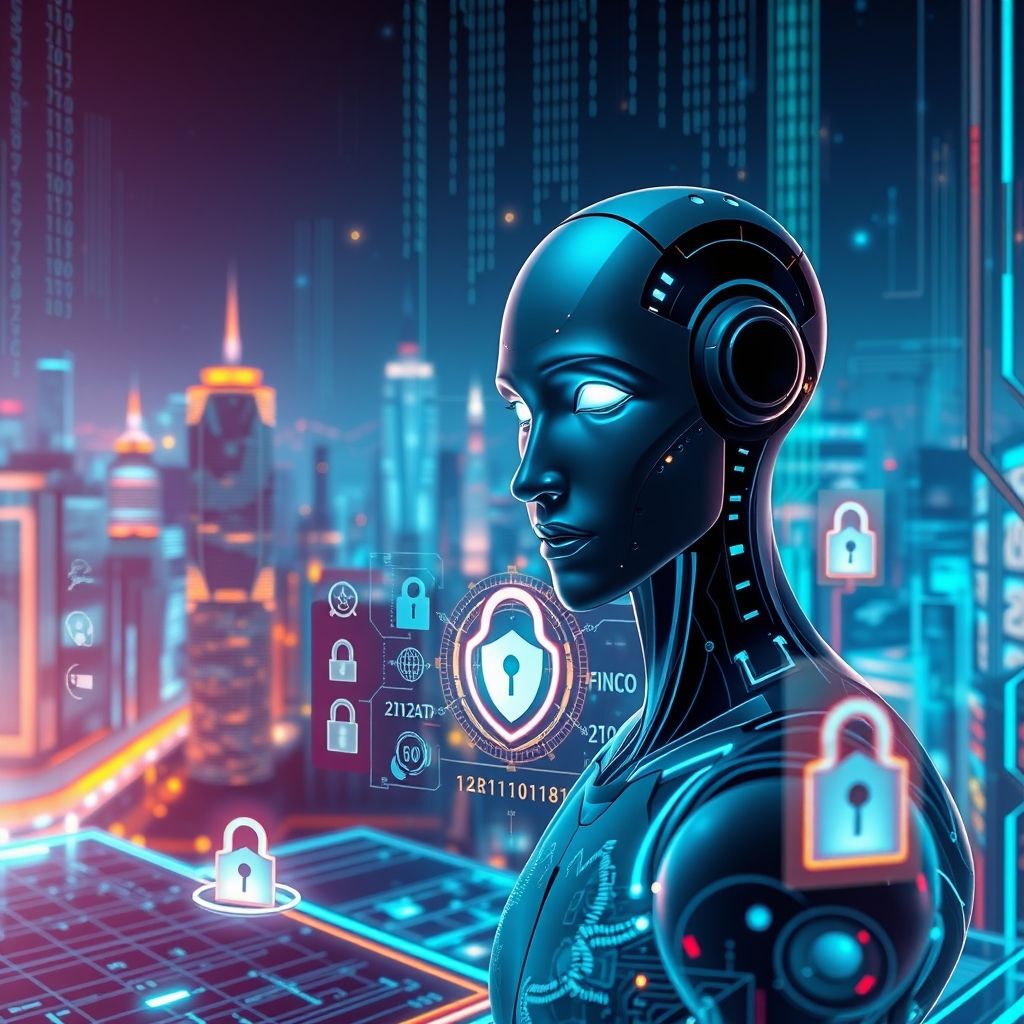Introduction: The Silent Guardian in the Age of Data
Imagine waking up to find that your bank account has been drained, your social media profiles hijacked, and your private photos leaked online. This isn’t the plot of a sci-fi thriller—it’s a real possibility in today’s hyper-connected world. Every day, millions of cyberattacks occur globally, targeting individuals, businesses, and even governments. In this digital era, where data is more valuable than oil, cybersecurity has become the invisible shield protecting our digital lives.
But here’s the twist: the very technology enabling our modern world—artificial intelligence (AI)—is now becoming a key player in defending it. From spotting suspicious login attempts to predicting cyber threats before they strike, AI is revolutionizing how we protect sensitive information. No longer just a tool for recommendation engines or voice assistants, AI is stepping into the role of a digital security guard, learning, adapting, and acting faster than any human could.
In this article, we’ll explore how AI is reshaping cybersecurity. We’ll dive into how it detects threats in real time, automates responses, enhances authentication, and even fights AI-powered attacks. Along the way, you’ll discover practical ways this technology impacts your daily life—and how you can benefit from its advancements. Whether you’re a tech enthusiast or just someone who uses a smartphone, understanding AI’s role in cybersecurity is no longer optional. It’s essential.
So, let’s unlock the digital vault and see how AI is becoming our most powerful ally in the fight for data protection.
1. Real-Time Threat Detection: AI as the Digital Watchdog
One of the biggest challenges in cybersecurity has always been speed. Cyberattacks happen in seconds. A malicious file gets downloaded, a phishing email is opened, and before anyone notices, sensitive data is compromised. Traditional security systems rely on known threat signatures—like a “mugshot” of past viruses—to detect attacks. But what about new, unknown threats? That’s where AI shines.
AI-powered systems use machine learning algorithms to analyze patterns in network traffic, user behavior, and system activity. Instead of waiting for a known virus signature, AI learns what “normal” looks like and flags anything unusual. For example, if an employee usually logs in from New York but suddenly attempts to access the system from Moscow at 3 a.m., AI raises a red flag.
This kind of behavioral analysis is already in use by companies like Google and Microsoft. Google’s AI systems scan over 500 million apps on the Play Store every day, identifying malware before it reaches users. Similarly, Microsoft’s Defender uses AI to detect over 60 billion security signals daily, filtering out real threats from false alarms.
Why does this matter to you?
Even if you’re not a corporate IT manager, real-time threat detection protects your personal data. When you shop online, use mobile banking, or connect to public Wi-Fi, AI is often working behind the scenes, silently blocking threats before they reach your device.
Key Benefit: AI doesn’t just react—it anticipates. By spotting anomalies early, it stops attacks before they cause damage.
But detection is only the first step. Once a threat is identified, what happens next?
2. Automated Response: Speed That Saves Seconds—and Millions
In cybersecurity, time is everything. The longer a breach goes undetected, the more damage it can do. According to IBM’s Cost of a Data Breach Report 2023, the average time to identify and contain a breach is 277 days. During that time, hackers can steal data, install ransomware, or sell access to other criminals.
This is where AI-powered automation becomes a game-changer. Instead of waiting for a human analyst to investigate an alert, AI can take immediate action. For instance, if a server starts sending large amounts of data to an unknown IP address, AI can automatically isolate that server, block the suspicious IP, and notify the security team—all within milliseconds.
Take the example of Darktrace, an AI cybersecurity company. Their “Antigena” system acts like an immune response for networks. When it detects a threat, it doesn’t just alert—it acts. In one case, Antigena stopped a ransomware attack in under 2 seconds by cutting off the malicious file’s communication before it could encrypt any data.
Practical Impact for Everyday Users:
Automated response isn’t just for big corporations. Cloud services like AWS and Azure use AI to monitor and protect user data. If a hacker tries to brute-force your cloud storage login, AI can lock the account, require multi-factor authentication, or even trigger a password reset—all without human intervention.
Did You Know?
AI can reduce response time from hours to milliseconds, potentially saving companies millions in damages and downtime.
Of course, automation brings concerns—what if AI makes a mistake? Could it accidentally shut down a critical system? These are valid questions, which is why most AI systems today work in “assisted mode,” where humans review major decisions. But as AI becomes more accurate, full automation is becoming a realistic—and necessary—option.
So far, we’ve seen how AI detects and responds to threats. But what about preventing unauthorized access in the first place?
3. Smarter Authentication: Beyond Passwords
Let’s face it: passwords are broken. People reuse them, write them down, or choose weak ones like “123456.” Even complex passwords can be stolen through phishing or data breaches. In 2023 alone, over 6 million passwords were exposed in public data leaks.
AI is helping us move beyond this outdated model with smarter, more secure authentication methods. One of the most promising is behavioral biometrics—a system that verifies your identity based on how you interact with devices.
Think about how you type, scroll, or hold your phone. Do you tap quickly or swipe slowly? Do you use one finger or two? AI can learn these subtle patterns and create a unique “digital fingerprint” for you. If someone else picks up your phone—even with the correct password—the AI might notice differences in typing rhythm or touch pressure and block access.
Banks are already using this. HSBC, for example, uses AI-driven voice and facial recognition to verify customers over the phone. The system analyzes over 100 voice characteristics, from pitch to speech patterns, making it nearly impossible to fake.
What This Means for You:
You’ll soon rely less on passwords and more on seamless, invisible security. Imagine unlocking your phone not with a fingerprint, but simply by how you naturally use it. Or logging into your email while AI quietly confirms it’s really you based on your browsing habits.
Pro Tip: Enable multi-factor authentication (MFA) wherever possible. When combined with AI, MFA becomes even more powerful—using location, device type, and behavior to verify your identity.
But as AI improves security, it’s also being used by attackers. This leads us to a growing arms race in cyberspace.
4. The Rise of AI-Powered Attacks: When the Defender Becomes the Attacker
For every shield, there’s a sword. As organizations use AI to defend their systems, cybercriminals are using the same technology to launch more sophisticated attacks.
AI can now generate highly convincing phishing emails. Tools like language models (similar to the one writing this article) can craft messages that mimic a CEO’s writing style, making them far more likely to trick employees. In one experiment, AI-generated phishing emails had a 40% higher success rate than human-written ones.
Hackers are also using AI to find software vulnerabilities. Instead of manually scanning code, AI can analyze millions of lines in seconds, identifying weak spots that humans might miss. This technique, known as “fuzzing,” is now automated and accelerated by machine learning.
Even deepfakes—AI-generated videos or audio of real people saying things they never said—are becoming a cybersecurity threat. Imagine a fake video of your company’s CFO authorizing a $1 million wire transfer. Without proper verification, such scams can succeed.
The Bottom Line:
AI is a double-edged sword. It can protect us, but it can also be weaponized. This means cybersecurity can no longer be a one-time setup. It must be dynamic, adaptive, and continuously learning—just like AI itself.
Real-World Example:
In 2022, a deepfake audio scam tricked a UK energy firm’s CEO into transferring $243,000. The fake voice perfectly mimicked his boss’s accent and tone.
So, how do we defend against AI-powered threats? The answer lies in using AI to fight AI.
5. AI vs. AI: The Cybersecurity Arms Race
The future of cybersecurity isn’t just about humans defending against hackers—it’s about AI systems battling other AI systems in real time. This “AI vs. AI” scenario is already unfolding.
Security companies are training AI models to recognize the patterns of AI-generated attacks. For example, AI can detect subtle inconsistencies in deepfake videos, like unnatural blinking or audio delays. Similarly, AI can identify phishing emails by analyzing linguistic patterns, even if the grammar is perfect.
One promising approach is adversarial machine learning, where AI is trained to anticipate how attackers might try to fool it. It’s like a chess game: the defender learns the attacker’s strategies and prepares counter-moves.
Google’s “Perspective API” uses this concept to detect toxic content online. By training AI to recognize manipulation tactics, it can filter out harmful content—including AI-generated disinformation.
Why This Matters to You:
As AI attacks become more common, only AI defenses can keep up. Your online safety will increasingly depend on invisible algorithms working behind the scenes, constantly evolving to stay one step ahead.
Good News:
AI defenses are improving faster than AI attacks. According to a 2023 report by Capgemini, 69% of organizations believe AI is essential to respond to cyber threats in real time.
But technology alone isn’t enough. Human oversight, ethical considerations, and public awareness are equally important.
6. The Human Factor: Why AI Needs Us
Despite its power, AI is not a magic bullet. It can make mistakes. It can be biased. And it can be tricked.
For example, if an AI system is trained mostly on data from corporate networks, it might not recognize threats in home environments. Or if it’s trained on outdated attack patterns, it could miss new tactics. This is why human expertise remains critical.
Cybersecurity teams use AI as a tool—not a replacement. Analysts interpret AI alerts, investigate false positives, and fine-tune models. They also ensure ethical use, preventing AI from invading privacy or making unfair decisions.
Everyday Takeaway:
You don’t need to be a tech expert to contribute. Simple habits—like updating software, using strong passwords, and being skeptical of suspicious links—still play a vital role. AI enhances security, but it doesn’t eliminate the need for vigilance.
Remember:
The strongest security system combines AI’s speed with human judgment and user awareness.
Moreover, as AI becomes more integrated into our lives, questions about privacy and control arise. Who owns the data AI collects? How transparent are these systems? These are conversations we all need to be part of.
7. The Future of AI in Cybersecurity: What’s Next?
So, where is all this heading? The next decade will likely bring even more advanced AI-driven security solutions.
Predictive Cybersecurity:
Imagine AI forecasting attacks before they happen—like a weather forecast for cyber threats. By analyzing global attack trends, geopolitical events, and network behavior, AI could warn organizations of potential risks days in advance.
Self-Healing Systems:
Future networks might not just detect and respond—they could automatically repair themselves. If a server is compromised, AI could restore it from a clean backup, patch the vulnerability, and resume operations without human input.
Decentralized AI Security:
With the rise of blockchain and edge computing, AI could operate in a decentralized way, making it harder for attackers to target a single point of failure.
Personal AI Guardians:
You might soon have your own AI security assistant—an app that monitors your devices, warns you of risky websites, and even negotiates with data brokers to delete your information.
Fun Fact:
Some researchers are developing “AI red teams”—systems that simulate cyberattacks to test an organization’s defenses, helping them improve before real hackers strike.
The possibilities are exciting, but they also come with responsibility. As AI takes on more critical roles, we must ensure it’s used ethically, transparently, and for the benefit of all.
Conclusion: Embracing the AI-Powered Future of Security
We’ve come a long way from simple antivirus software. Today, AI is transforming cybersecurity into a dynamic, intelligent, and proactive field. It detects threats in real time, responds automatically, enhances authentication, and even fights back against AI-powered attacks. For individuals and organizations alike, this means stronger protection, faster response, and greater peace of mind.
But AI isn’t a standalone solution. It works best when combined with human insight, smart policies, and user awareness. The future of cybersecurity isn’t about replacing people—it’s about empowering them with smarter tools.
As you go about your digital life—checking email, shopping online, or connecting to smart devices—remember that AI is likely working behind the scenes, guarding your data. And as these systems grow more advanced, your role remains vital: stay informed, stay cautious, and stay engaged.
Call to Action:
What steps are you taking to protect your digital life? Have you enabled multi-factor authentication? Do you trust AI with your data? Share your thoughts in the comments below—let’s build a safer digital world, together.
The age of AI-powered cybersecurity is here. It’s not science fiction. It’s reality. And with the right balance of technology and human judgment, we can make it a safer, smarter future for everyone.

Danilo Ferreira is a passionate entrepreneur, travel, and financial freedom enthusiast, always seeking new ways to expand his horizons and live with purpose. Driven by a high-performance mindset, he combines discipline and curiosity to achieve ambitious goals, exploring the world while building projects that reflect his vision of independence and continuous growth.







